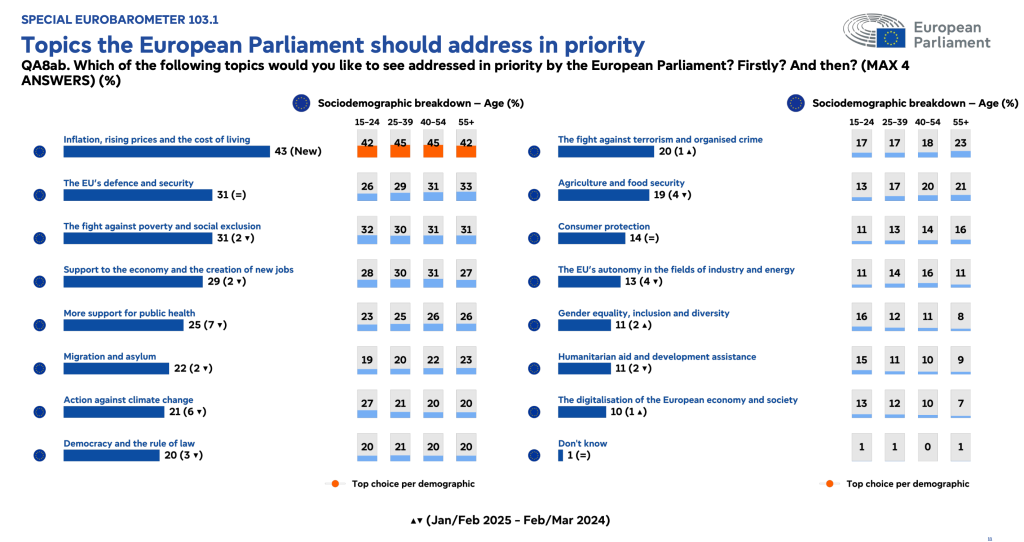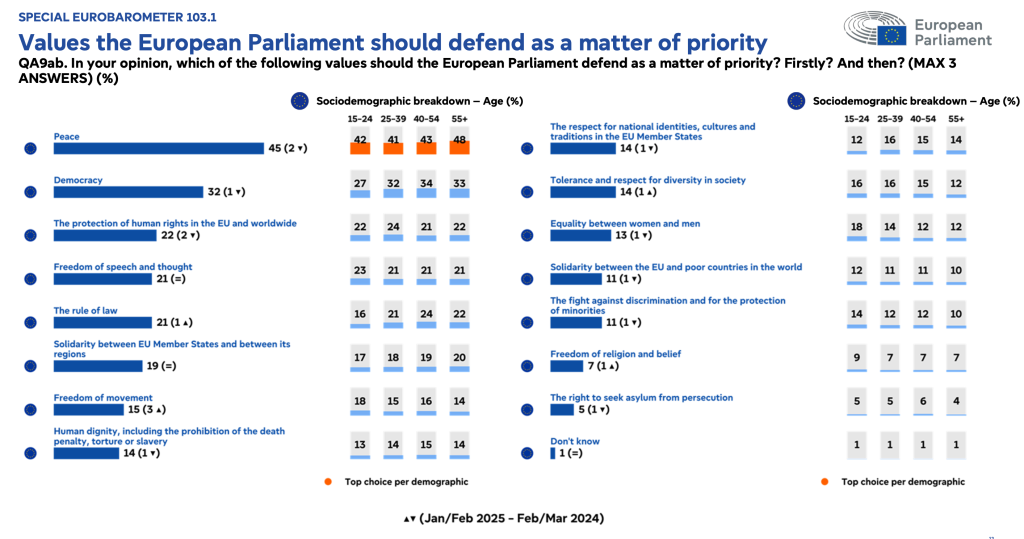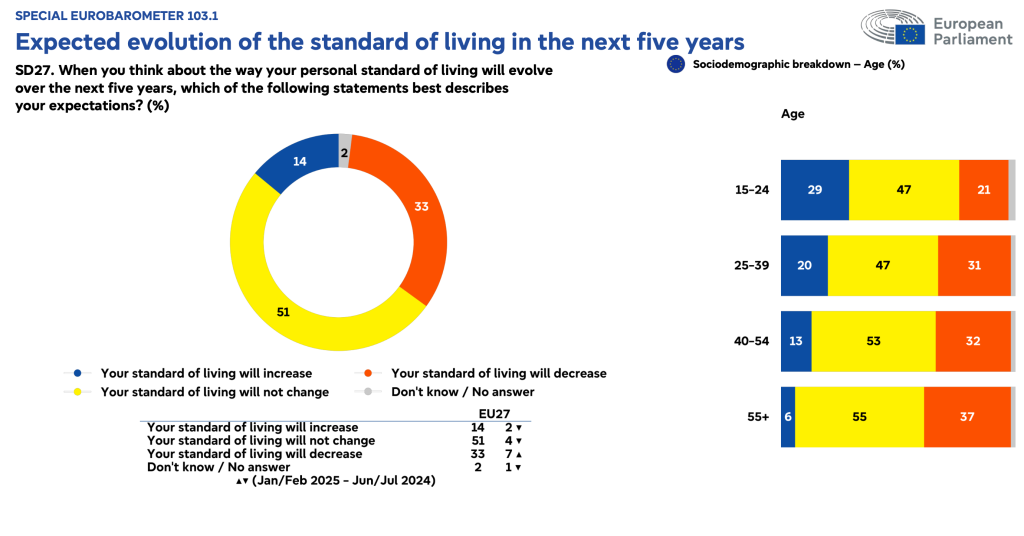Back at the end of February, we wondered how the Trump administration officials dressing down of the Europeans would mix with the relentless propaganda against Russia — specifically whether it would lead to a rally-around-the-EU-flag moment similar to the time after the official start of the Ukraine war in 2022.
That process is now in full swing and not just in Europe, but Canada too. Support for these EU and Canadian “rearmament” initiatives are being aided along by all the Trump noise. I say noise for the following reasons:
- The goals of the “West” still align against countries like China and Iran despite some differences over Project Ukraine.
- The Washington goal for some time has been to get Europe to shoulder a heavier burden. Perhaps it was time for a shove.
Ian Lesser, director of the Brussels office of the German Marshall Fund tells the New York Times the following.
“The advent of the Trump administration has given history a shove,” he said. “We’re not in a linear environment, with a linear spending trajectory.”
That same New York Times report mentions — as have many others — the Trump administration still supports NATO, plans to keep the American nuclear umbrella over Europe and remains committed to “collective defense.”
In the SignalGate messages, VP Vance laments “I just hate bailing Europe out again.” Vance argued that bombing the Houthis to protect trade routes through the Suez Canal would benefit Europe much more than the US since only “3 percent of US trade runs through the Suez” and “40 percent of European trade does.”
Well, that assumes that the US will be successful in “protecting” trade routes by bombing Yemen — which is far from a sure thing. And the US war crimes there are much more about bailing out Israel than Europe.
Nevertheless, Secretary of Defense Pete Hegseth agreed with Vance: “I fully share your loathing of European free-loading. It’s PATHETIC.”
Vance was also miffed that the “bailing out” of Europe goes against Trump’s “message” about the EU.
Even though Vance and Hegseth might be disappointed (that European nations aren’t bombing Yemen?), Trump’s “message” is still accelerating long-held dreams by neoliberal Atlanticists, such as the following:
- The crushing of the welfare states in Europe and Canada, which goes hand-in-hand with…
- “Rearmament.” Ultimately, the benefits of rearmament go first and foremost to the Western arms companies.
Now some EU plans look like they’re going nowhere fast. European Commission President Ursula von der Leyen’s 800 billion “ReArm Europe” brainchild doesn’t have the full support of bloc countries it needs. And others from High Representative of the European Union for Foreign Affairs and Security Policy Kaja Kallas to provide up to 40 billion euros in aid to Kiev and 5 billion euros toward providing Ukraine two million artillery shells this year are all but dead.
That being said, several EU countries are dramatically increasing military spending, most notably Germany, which under incoming Chancellor Friedrich Merz is losing its debt rules to spend big on its military.
And the EU, even if “ReArm” never takes off, there are plenty of other options on the table.
EU cohesion funds are financed by bloc governments in order to strengthen the economic, social and territorial unity of the EU through environment, transportation, and other infrastructure projects. Roughly one-third of the current seven-year EU budget of 1.2 trillion euros was for cohesion, but can now be used for defense.
The European Investment Bank (EIB) is being pushed to direct more money and its AAA credit rating towards militarization. In 2022, the EIB began funding for dual-use projects, and the portion of lending going towards mitigating climate change or fostering economic growth has steadily declined as more money goes to Ukraine and military projects, but it is still unable to directly fund the production of arms and ammunition — something that helps it preserve that AAA rating. Most bloc countries are pushing for that to change.
The Polish government recently announced that it will redirect 7.2 billion euros from its share of the EU’s post-pandemic recovery funds towards militarization spending. It’s the first — but perhaps not the last — bloc country to do so.
None of these plans deal with the issue of the EU’s lack of soldiers and dearth of young men willing to enlist nor with the fact that even prior to Project Ukraine, NATO already massively outspent Russia on defense, yet the dramatic redirection of money from social spending to weapons companies continues nonetheless.
It’s easy to see the dynamic at work here. Trump demands five percent of GDP spent on defense. NATO members go to 3.5 percent — a significant back-breaking jump from two percent. Ursula aims for 800 billion, but instead cohesion funds and EIB spending is redirected. And the more the Trump administration kicks the EU around, the more militarization initiatives in Europe gain support. That’s also the product of years of anti-Russia propaganda.
One feels the table is set for the next manufactured crisis to go for broke.
They’ve already got people taking to the streets to demand it.
The People Want War?
How genuine or realistic the Trump administration’s efforts are to end the war in Ukraine are debatable, and conclusions often change by day. (And let’s not forget Russia has the ultimate say.) But one thing is certain: just by making noise about peace in Ukraine and leaving Europe to fend for itself, Trump has helped sell European militarization spending.
Here’s a piece from the Associated Press, “Tens of thousands join pro-Europe rally in Rome, amid worries over European Union’s plan to rearm.” This is in Italy, one of the least supportive publics in Europe for Project Ukraine with major class divergence on the benefits of EU membership, so that gives you an idea of the crowd likely skewed, but still.
Tens of thousands of Italians joined a pro-Europe rally in Rome’s city center Saturday, waving blue European Union flags in a sign of support and unity as a European push for rearmament divides the country.
The initiative, supported by most of the center-left opposition parties, despite their different positions, was launched by Italian journalist Michele Serra at the end of February, with an editorial in the Italian daily La Repubblica titled: “Let’s say something European.”
“I wanted to organize a large demonstration of citizens supporting Europe, its unity and its freedom, with no party flags, only European flags,” Serra said, launching the slogan: “Here we make Europe, or we die.”
The initiative was born in response to U.S. President Donald Trump ’s destabilizing policies, which created an unprecedented rift between Europe and the U.S., strained over the war in Ukraine and an ongoing tariff battle.
Italian Premier Giorgia Meloni has reluctantly backed an EU plan to rearm Europe over concerns that the proposal by European Commission President Ursula von der Leyen might weigh on Italy’s giant debt, diverting much-needed funds to weapons spending.
Depending on where you sit, getting 30,000 out to protest for weapons manufacturers profits and the gutting of social services could be considered either an impressive or depressing achievement. Nevertheless, is it representative of the wider mood?
A few recent polls have some interesting findings. Eurofound shows a slight reversal in the trend of European publics souring on Project Ukraine:
A more extreme case of Trump-inspired EU militarization fever can be found in bloc’s recent Eurobarometer survey. The poll, conducted for the European Parliament in January and February, found that 74 percent of EU citizens thought their country benefited from EU membership. That’s the highest recorded level since the question was first asked in 1983. Why are people feeling the love for Brussels? Because the EU “strengthens security”:
There’s also this:

As always, these results should be taken with a grain of salt since it’s in the EU interest for citizens to support more centralization in the name of “protection.” And so the results are also interesting for what the EP chose to emphasize and subsequent media reports chose not to highlight, including the following:

Or how about the following?

Most of those values are under threat from the EU, not by any outside forces. While they might have gotten numbers they craved on “the role of the EU to protect,” the increased support for Brussels comes despite the realization beginning to break through that life will not be getting any better:

That will no doubt still be the case even once the Trump shock is gone and the rally around the flag euphoria wears off — just as it did following the start of Russia’s special military operation in 2022.
Neoliberal Warmongers’ Reprieve
One area the Trump effect is more clearly showing itself is in bumps of support for Western politicians and parties thoroughly discredited for their Project Ukraine support in recent years and the disastrous effect it has had on economies at home. Here’s FT:
Canada’s ruling Liberal party was facing a humiliating loss in upcoming elections. Then came Donald Trump.
Party leadership contenders vied to display strength against the US president, his tariffs and his desire to take over Canada – and Liberals’ poll ratings began surging. Under new prime minister Mark Carney, with the slogan “Canada strong”, the party is now narrow favourite to win a historic fourth straight term.
The former Bank of England governor has become emblematic of global leaders enjoying a ratings bump after going head to head with Trump.
Polling in several countries, from Mexico to Ukraine, shows even unpopular leaders like France’s Emmanuel Macron are enjoying some relief from voters as they seek to ward off menaces including tariffs, the withdrawal of military support and even the threat of US conquest.
Even Zelesnky, who has Ukraine on the verge of extinction, has got wind in his sails:
Zelenskiy’s overall approval rating has shot to 67 per cent while his net approval is 38 per cent – the highest scores since December 2023 – even as he seeks to mend relations by accepting Trump’s proposed minerals deal and partial 30-day truce.
Trump’s comments were seen as “unfair, a stab in the back” and “a wider attack on the country, rather than just criticism targeting the president”, said Anton Hrushevsky of the Kyiv International Institute of Sociology.
Macron is going to need a lot more help (like, say, the barring of his main rival from office), but he’s up six percentage points to a depressing 27 percent in an Elabe survey this month. UK Prime Minister Keir Starmer who’s even more impressive than Macron in that he sunk to similar approval levels in a fraction of the time, saw a double digit rise in approval rating as the UK public rallies around the Starmer slime in the face of what they view as Trump’s unfair treatment of Ukraine. Nathalie Tocci, director of Rome’s Institute for International Affairs told FT the following:
“You have this bully that is smashing the system. Rather than just kissing the ring, these leaders basically stand up and politely say ‘no’, and their voters appreciate the fact that they are not being colonised.”
But is that really true?
Beneath the Surface It’s Business As Usual
Europe still refuses to do anything about the energy elephant in the room and despite all the big talk remain mostly subservient to the US.
Canadians might be flying the maple leaf everywhere you look, but how’s that surge of patriotism playing out in Ottawa?
Canada is in talks to get in on the EU’s increased military spending. Brussels says it wants to prioritize European-made products, but there are doubts about that. According to the Stockholm International Peace Institute:
Arms imports by European states were 94 per cent higher in 2019–23 and 55 percent came from the US, a substantial increase from 35 per cent in 2014–18. The next largest suppliers to the region were Germany and France, which accounted for 6.4 per cent and 4.6 per cent of imports, respectively.
The EU, as part of the Trump spat, is looking to reduce that dependence and is hoping on Canada. According to the New York Times, “Canada, according to the terms of the discussion, would also be given preferential access to the E.U. market for military equipment, an alternative to buying equipment from the United States.”
There are issues there, as well:
Canada’s military industry, which is relatively small, has been used to produce Canadian equipment but has also been a regular contractor for building American military equipment or parts. Canadian factories across the vast country produce munitions, tanks, aircraft, technological defense systems and navy ships.
An in-depth industry review in 2022 found that about half of Canada’s military equipment was exported and half kept domestically. The top export destination, by far, was the United States.
In the meantime, Ottawa is sending billions to one of Canada’s wealthiest families in the name of defense. From The Breach:
The Liberal government has handed $8 billion to one of Canada’s wealthiest families—and they’re counting on Canadians not to notice.
The deal awards Irving Shipbuilding, owned by the notorious Irving dynasty, a six-year contract to start building three new destroyers for the Canadian navy. Even military insiders have slammed it as wildly overpriced.
And that’s just the tip of the iceberg. By the government’s own estimates, the ships won’t be finished until 2039—and by then, the total cost will have ballooned to at least $22 billion.
The government boasted the deal will help protect Canada’s sovereignty and create jobs. But at a time when Canadians are struggling with the cost of living, a crumbling healthcare system, and a planetary crisis, it’s clear what this really is: a massive corporate handout in disguise.
An enormous grift? Sure, but it must be done due to Trump’s threats to Canada’s national security. Canada is spending another $6 billion to develop an Arctic radar detection system — again part of the US desire to militarize the region, which European countries like Sweden, Finland, and Norway are also helping with.
The UK just announced it’s going forward with buying more F-35s despite all the supposed worries about a Trump kill switch. Canada, too, has yet to cancel its purchase of 88 F-35s costing more than $14 billion — although Ottawa says it’s “doing its homework.”
To make it abundantly clear where these governments priorities are, these massive expenditures come as the UK slashes benefits for those with disabilities (and won’t even make a document describing the cuts available to blind people set to have support slashed), and Canada offers more support for the disabled to die than to live.
And incoming German Chancellor Friedrich Merz touts his plans for further cuts to Bürgergeld and other social spending as Germany authorises 1 trillion euros in new loans for militarization.
Canada and the EU continue to do the empire’s bidding against the likes of China and Iran and play along in Syria and elsewhere. The Italian-owned Mediterranean Shipping Company is working with the Trump administration and Blackrock to take over a portion Middle East shipping infrastructure — a big part of the US strategy to reverse the tide of China’s growing control over global logistics.
Ottawa is engaging in its own trade war against Beijing, which is approved of by Washington. The EU is making noise about rapprochement with China, but there has been no movement yet, and many in Brussels are offering to get even tougher on Beijing as a way to please the US.
Meanwhile, there’s still no peace with Russia as the Atlanticists enact what have been their goals all along — primarily other members of NATO spending a lot more. As Politico put it, “One imagines that Trump administration officials are patting themselves on the back for finally getting the Germans to take more drastic action on defense spending, meeting a long-time goal of many U.S. administrations to strengthen the European pillar of the transatlantic alliance.”
Yes, there have been calls for this for years, and they ramped up considerably after the beginning of Russia’s SMO. Here is just one example from the influential Center for Strategic and International Studies (CSIS) writing last year in Foreign Affairs about Washington’s need to focus on China:
That complicated reality requires U.S. allies, especially in Europe, to take on a larger share of directing the containment of Russia. Europe has shown its political and economic resilience in the face of Russian aggression. Yet militarily, the continent remains dependent on the United States. This dynamic must change, in part because the United States must commit more of its resources to Asia. The growth of European defense spending since Russia’s full-scale invasion of Ukraine is an encouraging step. In 2023, 11 NATO members hit their spending target, allocating at least two percent of GDP to national defense, up from just seven members in 2022. The rest need to follow suit.
It might be a stretch to say it’s all part of a coordinated plot, but while the increase in military spending might be coming amid a war of words — and some tariffs — the Atlanticist think tanks funded by and expressing the will of American plutocrats are getting what they wanted — and in some cases even more.


